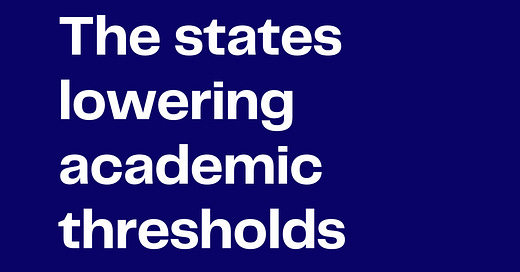Here’s a topic that doesn’t get enough attention: a number of states are handling pandemic-era student achievement declines by lowering the bar for academic success.
Most notably, some states have adjusted their ‘cut scores’ for determining proficiency on state tests. It’s a sleight of hand: the share of students considered “proficient” increases, even as student performance doesn’t improve. This makes schools look better, yet it’s controversial even among educators.
Linda Jacobson has reported on the issue in The 74, and Frannie Block just gave it a national spotlight in The Free Press.
Other states have lowered or eliminated high school graduation requirements, in the continuation of a twenty-five year trend.
I’m grateful for the media attention, and believe this conversation needs more visibility. We also need a comprehensive and current picture. I asked around for a complete list of states that have made changes since the pandemic, and one doesn’t seem to exist.
So, here’s my crack at it.
States Adjusting Proficiency Measures:
These states have changed proficiency thresholds since 2020:
These states are contemplating such changes:
States Softening Graduation Requirements:
These states have weakened graduation requirements since 2020:
I’m pretty sure this list is incomplete; Please help me flesh it out! Which brings me to…
Help Me Out Here
This is an exercise in crowdsourcing.
I’ll maintain a list of states where these changes are happening, linking to info for each state.
Please comment with additional states or better info sources.
I have done this sort of crowdsourcing frequently in Twitter, but as I rethink the platform landscape, I sense Substack is now the better launchpad for these conversations – and certainly for list maintenance.
Additional Reading and Reflections
How good are your state’s proficiency benchmarks? A new FutureEd report lets you compare your state’s proficiency threshold to its results on the NAEP, our “national report card.” The NAEP standard is known to be high and it hasn’t wavered over time, so it’s a solid benchmark. Spoiler: most states report higher reading and math proficiency on their own assessments than the NAEP reports, often by a large margin.
We need to be able to learn from state trends and cross-state comparisons, in an era when 45 states have adopted new litracy legislation and we have leaders to learn from.
Let’s signal to state leaders that random changes to state proficiency thresholds are unacceptable, and won’t go unnoticed.
This post published on February 10th, 2025. As it is updated, its freshness date will be noted here.
This is the first post on my new Substack! Please consider subscribing. Subscriptions are free. I’m also weighing the need for a weekly roundup on literacy and learning; pledge to up-vote the idea.




Alabama should be added to your list, though they're doing a strange mix of both lowering at 3rd grade and raising at 4th grade. See this article: https://www.al.com/educationlab/2024/06/shifting-terms-cut-scores-complicate-alabama-3rd-grade-reading-efforts.html
Just because standards have been developed, does not mean they were developmentally appropriate. Several years ago I participated in a "bulletin board" that covered education topics. A middle school social studies teacher had been on the most recent (at that time) K-12 Social Standards committee for the state of CA. He reported to us that the committee began by asking the college level instructors and professors who were on the committee what knowledge they hoped incoming college freshman would bring with them. Once the committee articulated what graduating seniors should be able to know and do in their discipline, they built standards down from there. The project endeavored to plug skills into the K-12 standards, but was not concerned with what may or may not be developmentally appropriate for the age and grade level. It was just creating standards to fulfill the wishlist of college professors.